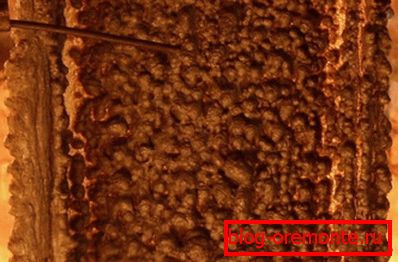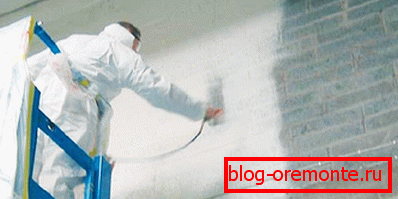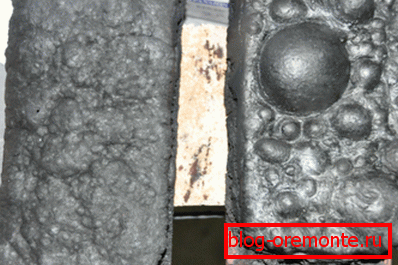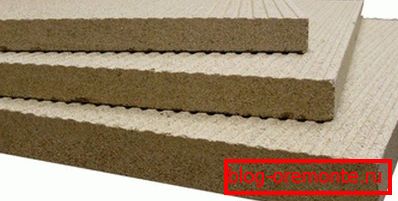Fire protection of concrete: the use of special paint
Fire protection of reinforced concrete structures has become demanded literally since the advent of technology that allows to produce concrete goods. The relevance of fire treatment in relation to construction sites and structures is not accidental, since this is a unique opportunity to prevent damage to both the building itself and the property located in it.
In this article, we will look at how and with the use of what materials fire protection of concrete structures is performed.

Features of fire treatment of reinforced concrete structures

Reinforced concrete fire protection is a series of activities carried out in accordance with the requirements and instructions given in SNiP 2.01.02-85.
Based on these standards, construction sites and structures are divided into 8 types according to the degree of fire resistance. In this case, the resistance to the effects of critical temperatures of the object as a whole and all elements of the building made with the use of cement-containing mixtures reinforced with metal fittings is considered.
Based on the compliance of the actual and required parameters of fire resistance of buildings and structures, the decision is made on the use of various fire safety methods. Consider the features of the choice of optimal methods that are able to protect the construction site from the destructive effects of open flame and critical temperatures.
Current methods of protection of concrete products from open flame

The main task of the fire protection of concrete products is to apply a heat-insulating screen to the surface of the material, which, in turn, will not allow the concrete to be heated to critical temperatures for a certain time.
The effectiveness of the listed insulating materials is determined in accordance with the NBP 236-97.
Important: In assessing the fire retardant performance of materials and methods for processing concrete products, the time period from the beginning of the thermal effect and up to the limit state is taken into account. Under the limit state, in relation to concrete products, it should be understood temperature equal to +500 ° C.
In accordance with the NBP 236-97, it is customary to distinguish between 5 types of flame retardant efficiency:
- 150 min and more - 1 group;
- 120 min and more - 2 group;
- 60 min - 3 group;
- 45 min. - 4 group;
- 30 min. - 5 group.
Currently, among the materials that can serve as an effective thermal insulation screen, it should be noted:
- special paint coatings;
- thermal insulation plaster;
- vermiculite plates.
Let us consider in more detail the features of the application of each of the above thermal insulation materials.
Special paint coatings

Fireproof paint on concrete is the most popular and technological material used in the processing of concrete products.
Among the advantages of this method of protection of reinforced concrete structures and structures should be noted:
- Ease of application with various available tools, including a roller, brush or airless application devices when machining large structures;
- Ability to use when processing hard-to-reach areas of reinforced concrete, therefore, no need to cut reinforced concrete with diamond circles to dismantle those or other structural elements;
- The stability of coatings to negative environmental factors and, as a consequence, the possibility of using both inside and outside construction sites;
- The durability of the finished product, subject to proper application in accordance with the manufacturer's instructions;
- Reasonable price in comparison with other ways of heat insulation.
Fire retardant paint for concrete is of two main types - intumescent and non-intumescent.
- Non-intruding compositions at the occurrence of critical temperatures do not change their standard sizes, and their volume remains unchanged.
- Intumescent formulations, when exposed to an open flame, increase in volume. The degree of change in the size of the coating is determined by the specific type of composition.

The principle of action of the special paint and varnish intumescent compositions is as follows. With the beginning of the fire, the air temperature rises, as a result of which a chemical reaction starts in fire retardant paints. As a result, the paint decomposes and in this case there is an intensive absorption of heat.
Simultaneously with the absorption of heat, such compositions emit non-flammable gases into the environment, creating coked foam, due to which the coating swells with a change in volume tenfold in comparison with the original parameters.
The formed nakoksovanny foam provides the most stable protection against high temperatures for the time required to neutralize the source of fire and eliminate the consequences of a fire.
Thermal insulation plasters and pastes

Fire protection of concrete and reinforced concrete objects and structures can be carried out by plastering. In this case, special plaster compositions and pastes are used. The application is carried out mechanically using wide brushes or special spray equipment.
Important: A layer of plasters correctly applied on concrete does not exceed 4 cm, while pastes are applied with a layer no thicker than 1 cm.
A distinctive feature of special plastering compositions is the absence of a mixture of Portland cement and quartz sand as a binder.
The absence of cement is not accidental, since this material, when exposed to critical temperatures, emits calcium hydroxide, which decomposes at +550 ° C. As a result, cracks and cement-containing plasters are not able to interfere with the effects of the flame.
The composition of effective flame retardant pastes and plasters include a binder based on gypsum, silicate water glass, alumina and pozzolanic cements.
In addition, expanded perlite, vermiculite, diatomite, volcanic tuff and other heat-resistant materials can be used as a filler. Some varieties of plastering materials include fibrous fillers, such as kaolin wool and fluff asbestos.
Use of vermiculite plates

Instructions for the use of vermiculite plates as thermal insulation of reinforced concrete structures and structures is simple.
An important condition in which the required degree of protection will be guaranteed is a tight fit of the plates as to the concrete surface and to each other. This condition is especially relevant if diamond drilling of holes in concrete or other mechanical surface treatment was carried out.
This material has the following advantages:
- The complete absence of toxic secretions even when exposed to very high temperatures;
- Simplicity and short time of installation with the use of special fasteners and heat-resistant glue, ensuring the tightness of the protective finish;
- The possibility of applying a finishing on top of the installed plates, which is especially important when protecting residential buildings.
Conclusion
Is there a need to improve the fire safety of the house with your own hands? There is such an opportunity, the main thing is to choose the right technology for conducting thermal insulation works and apply suitable materials for this.
Now that you know how and how to protect concrete from an open flame, it will be easy to cope with this task. You can find more useful information by watching the video in this article.